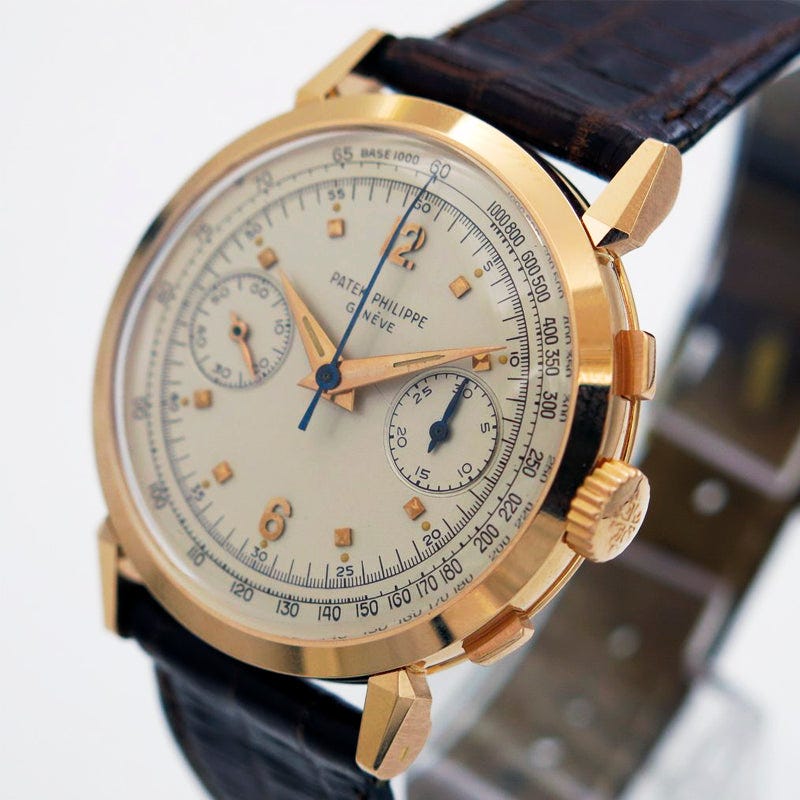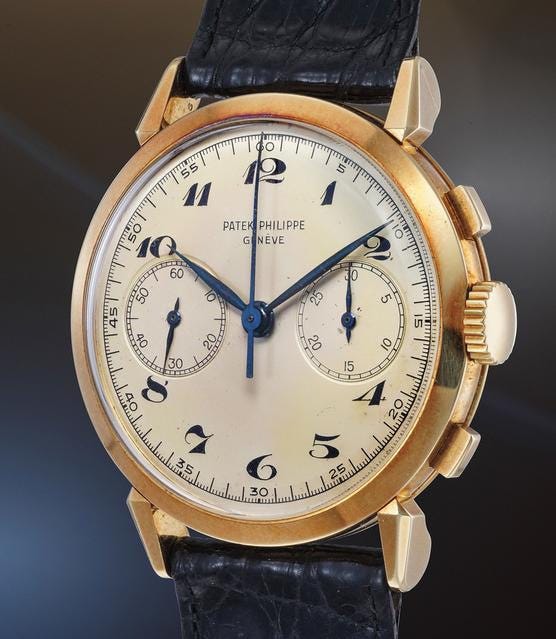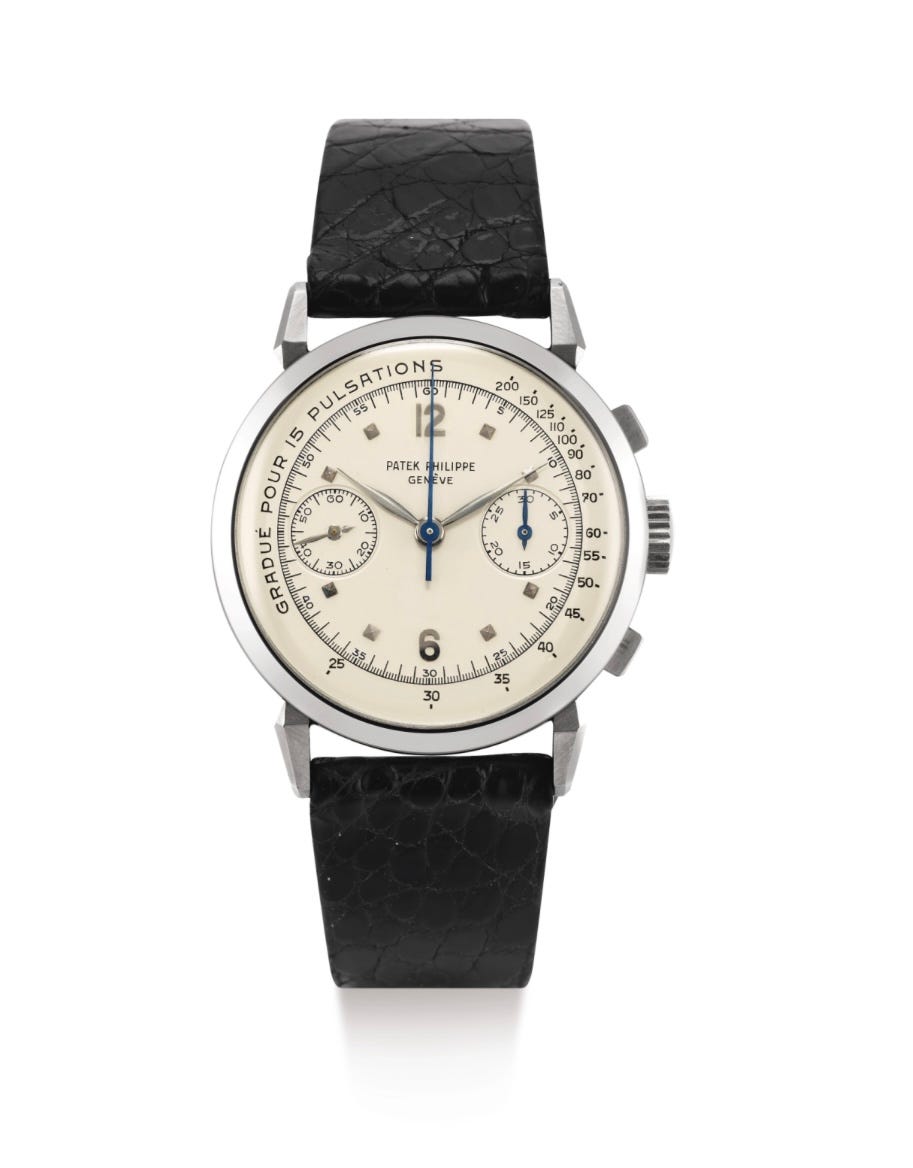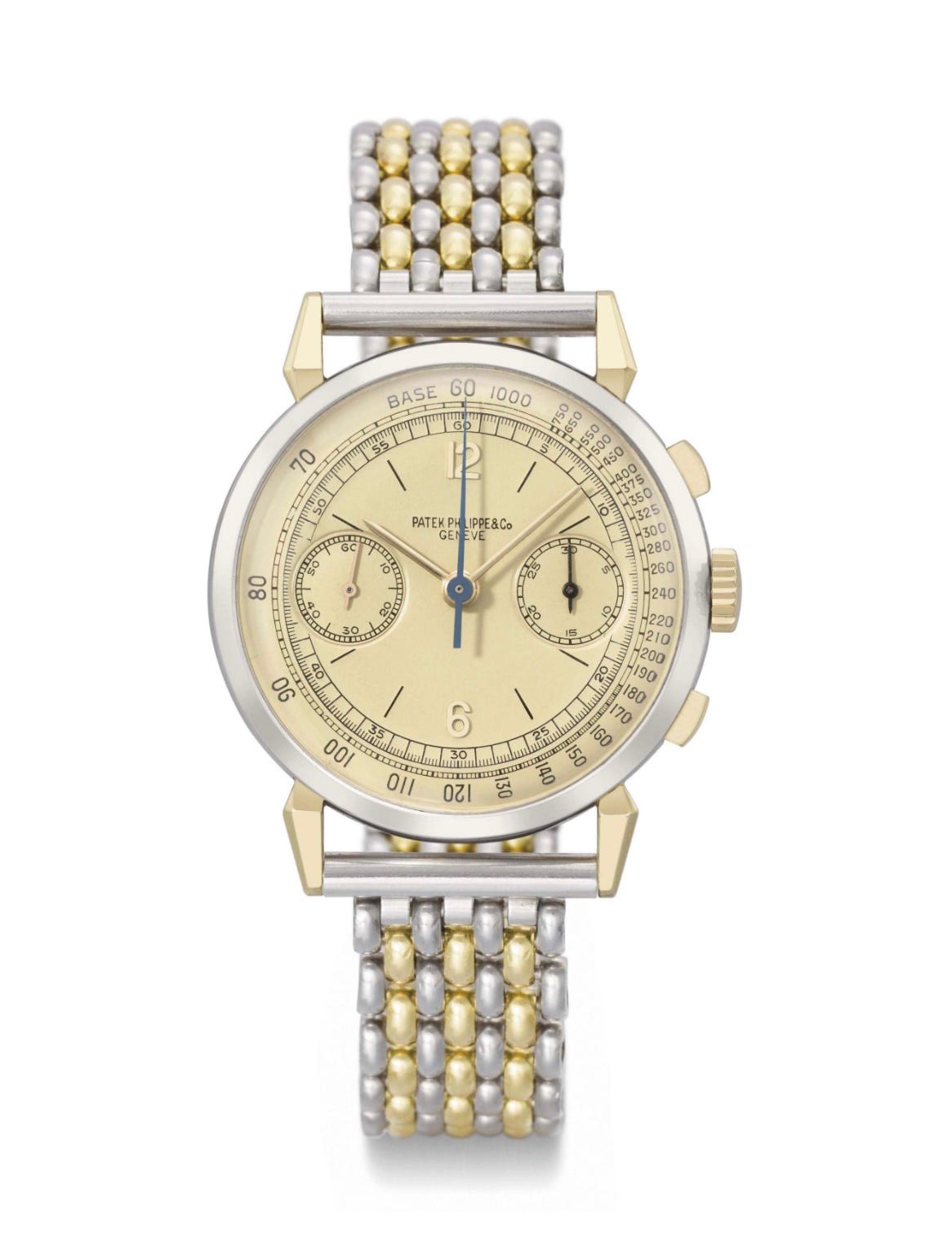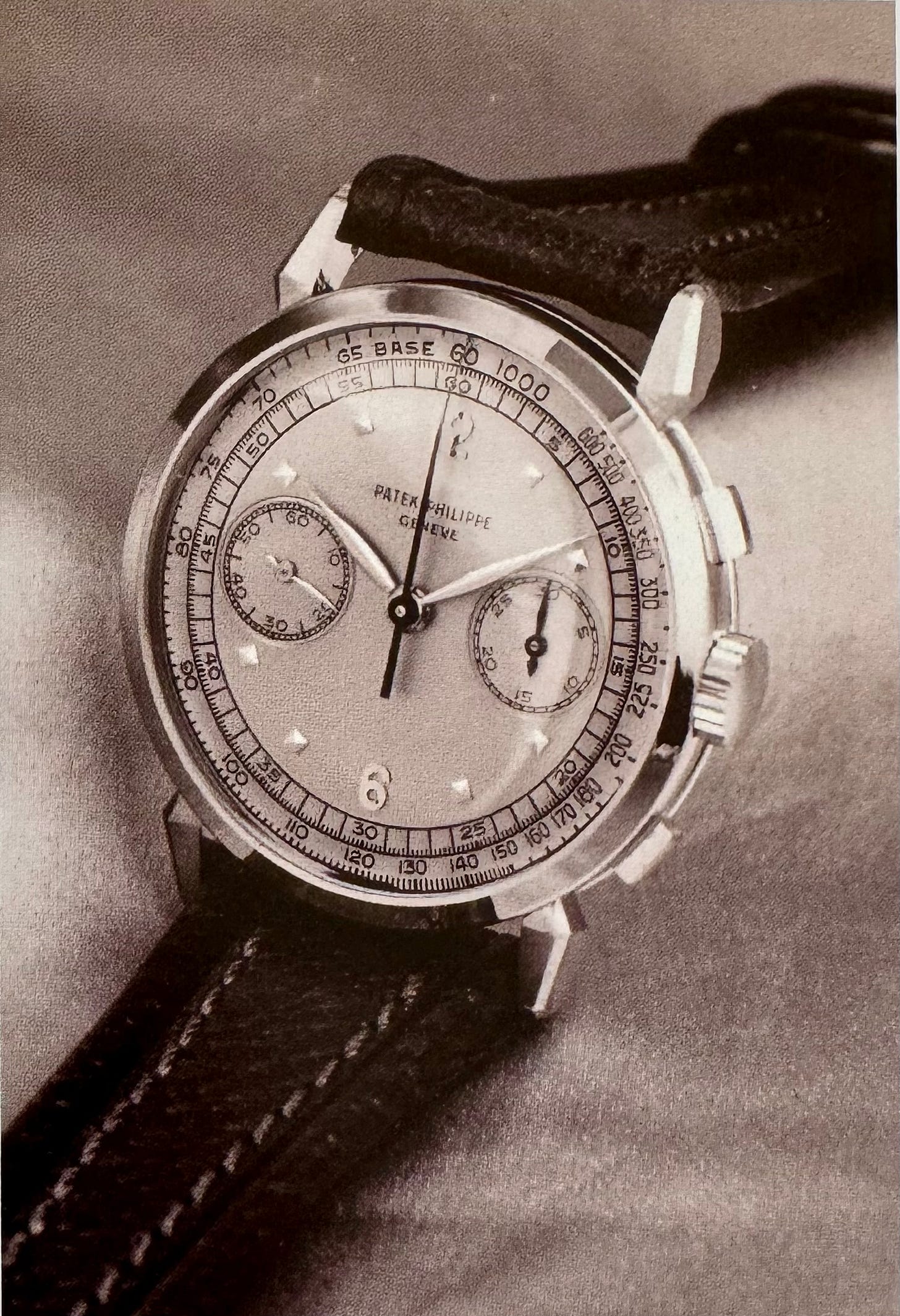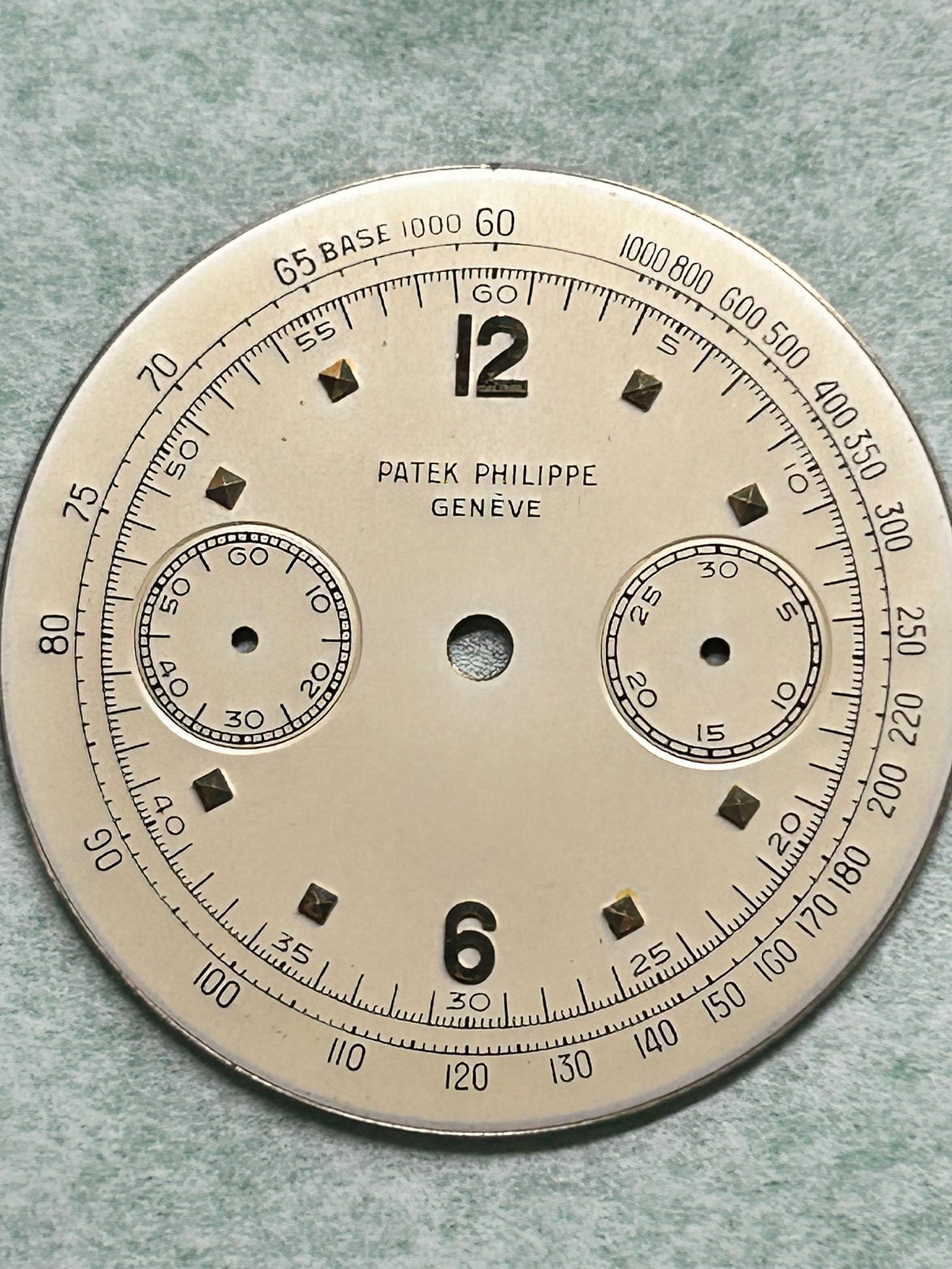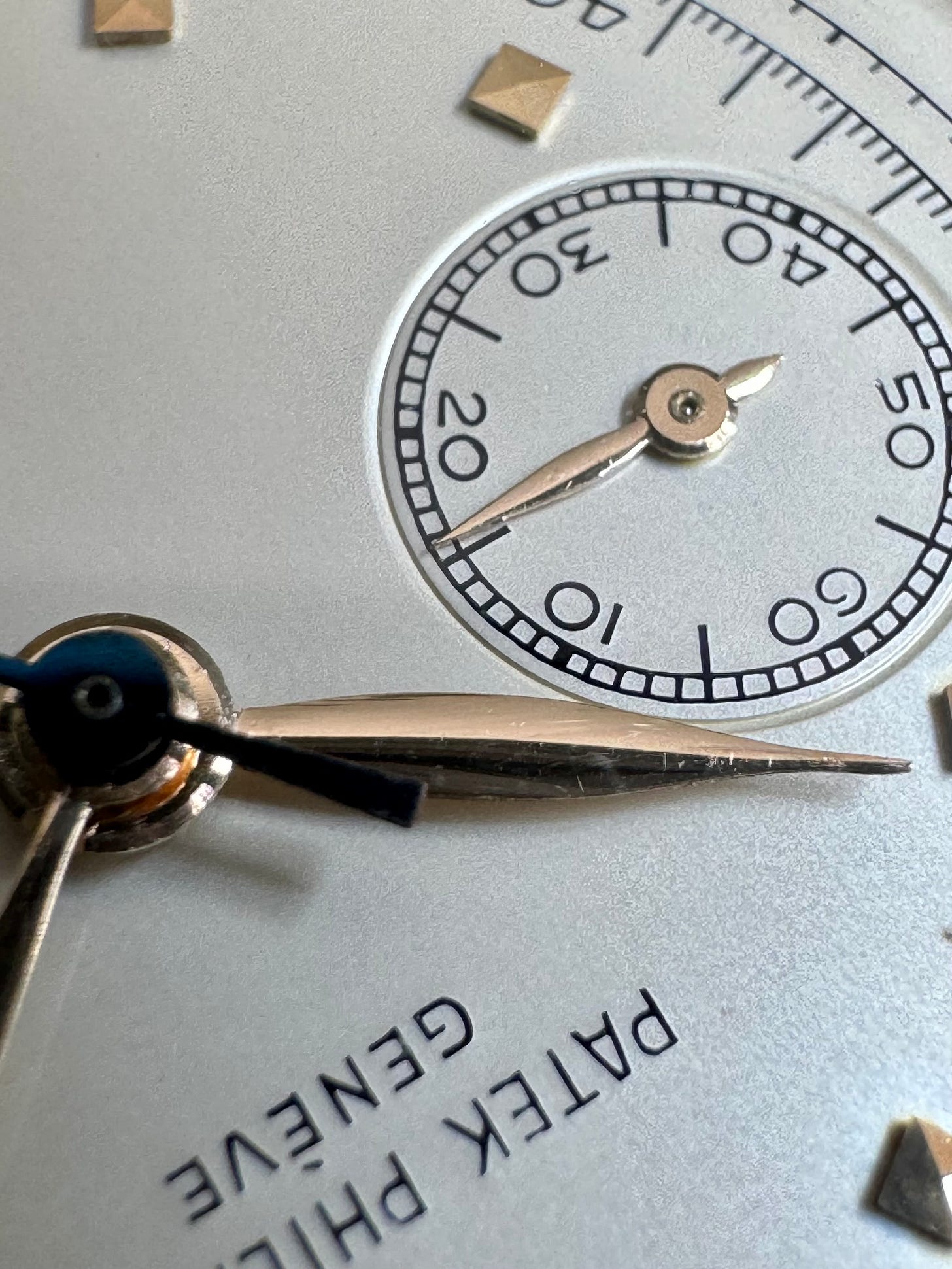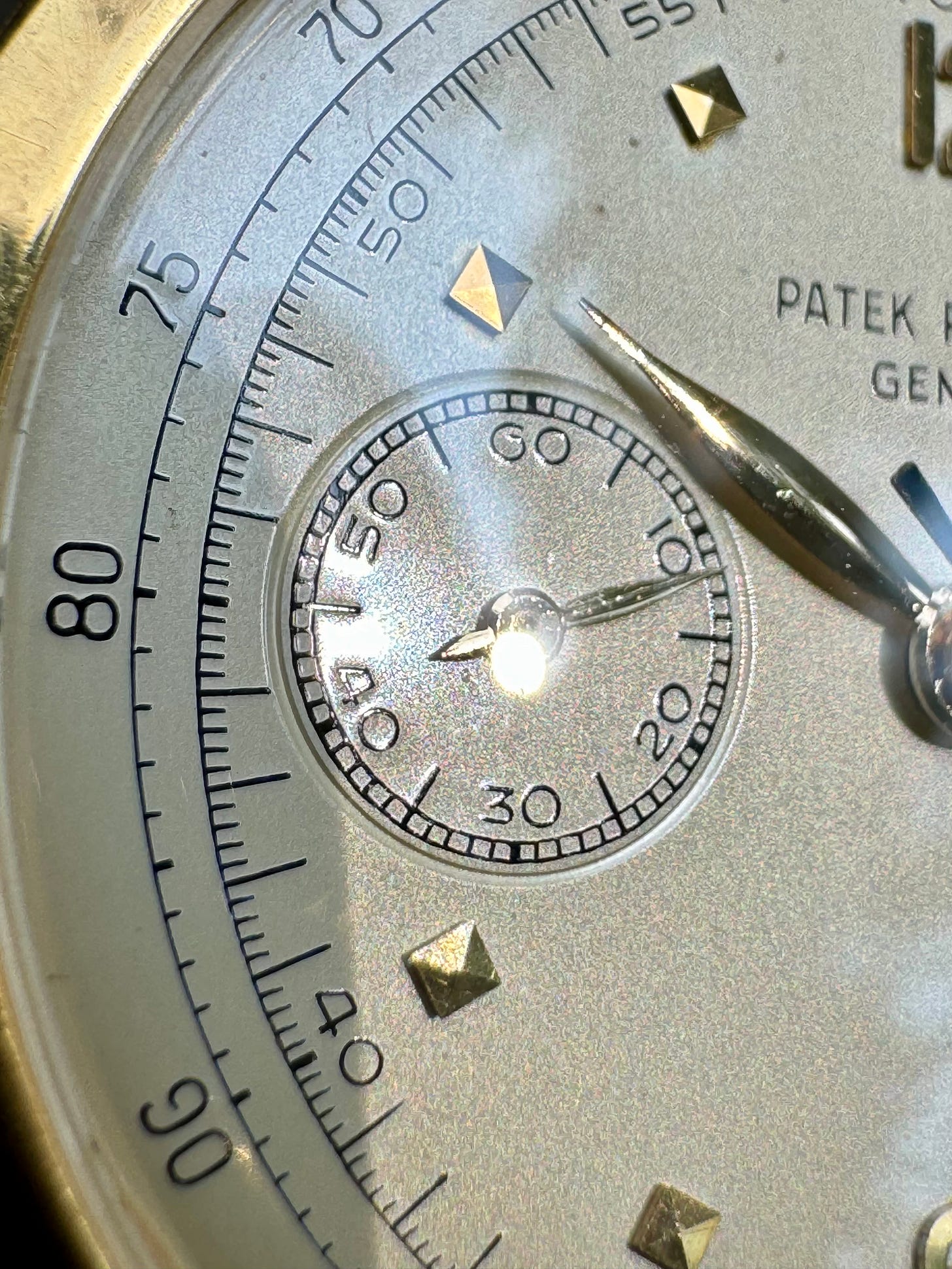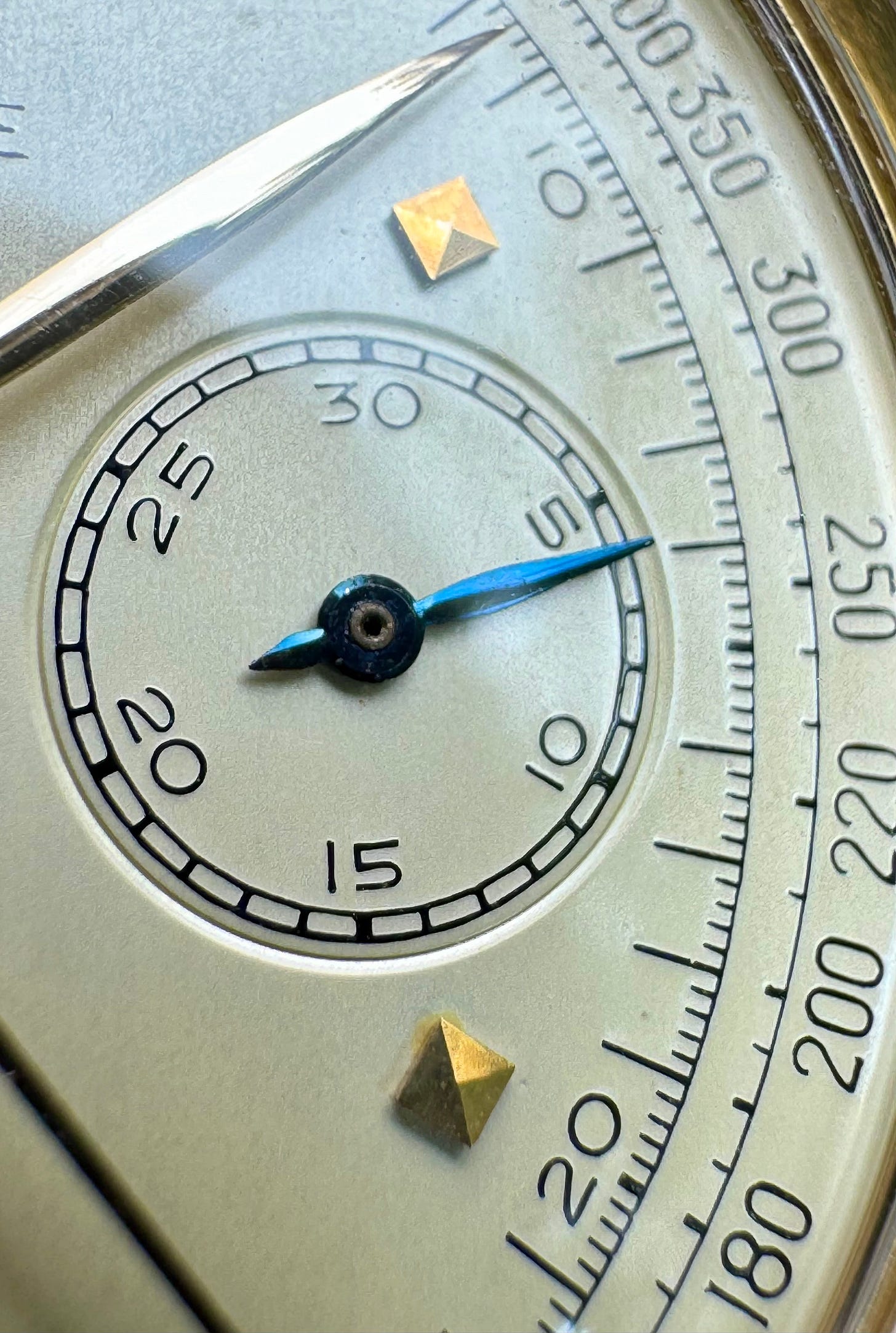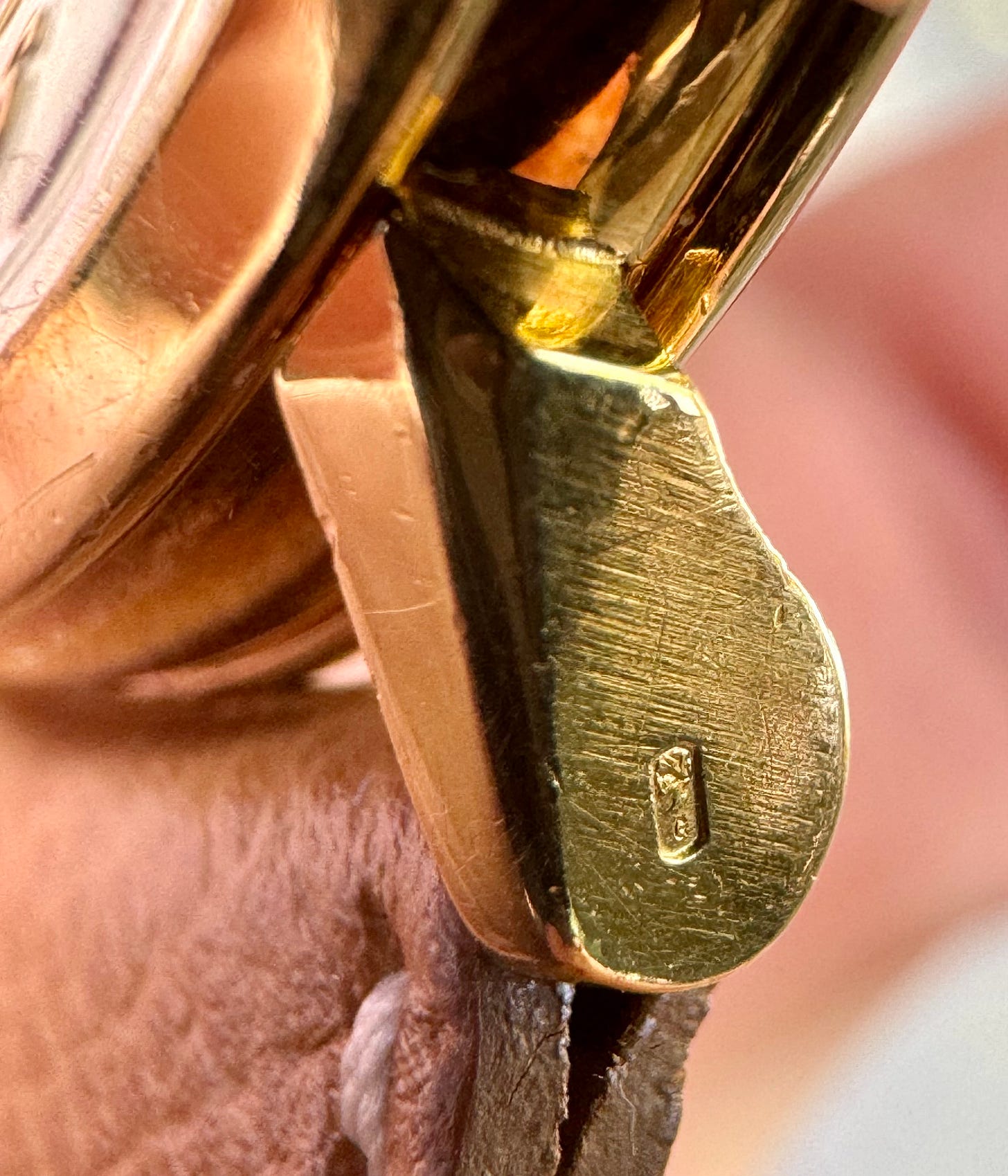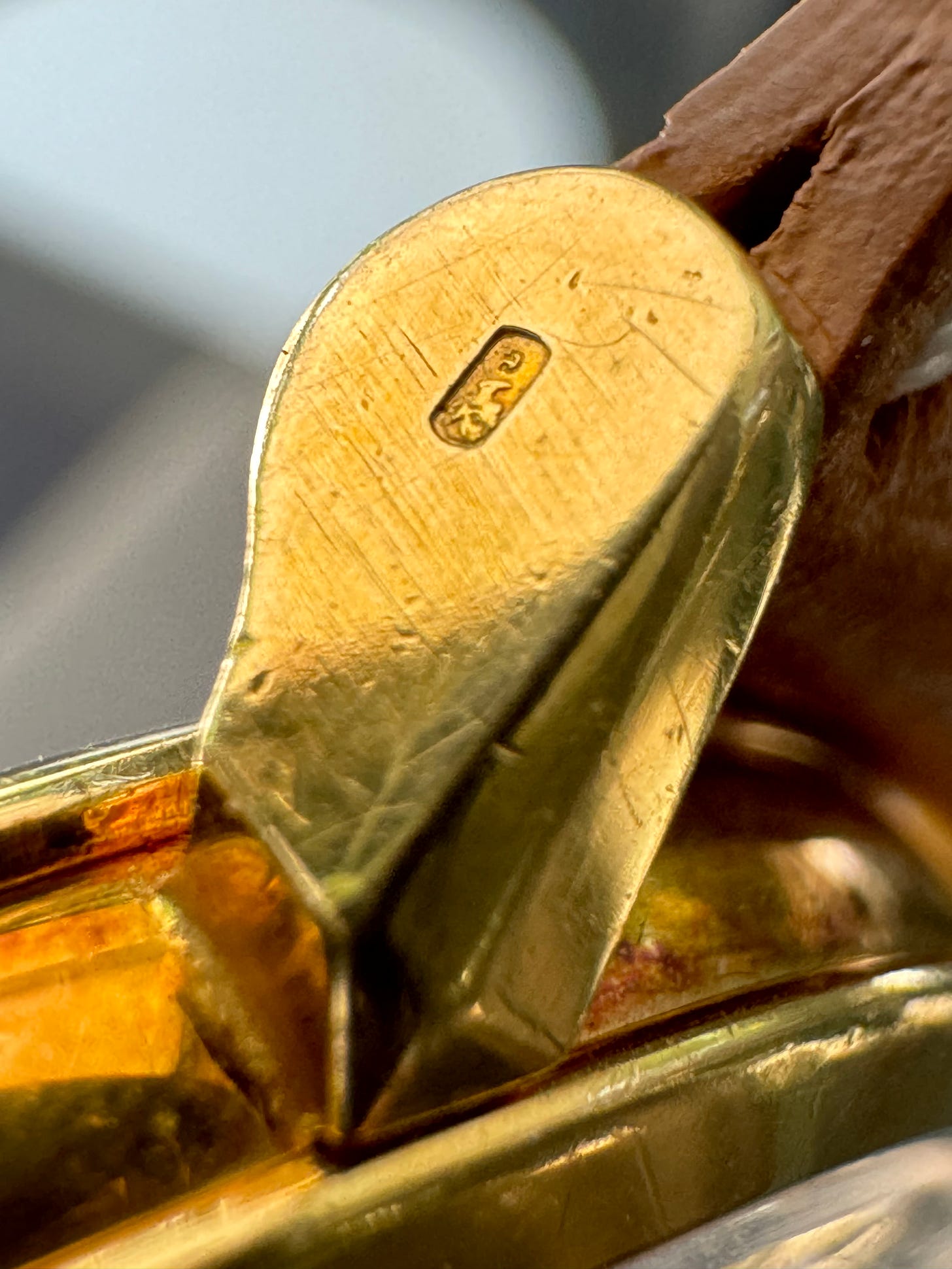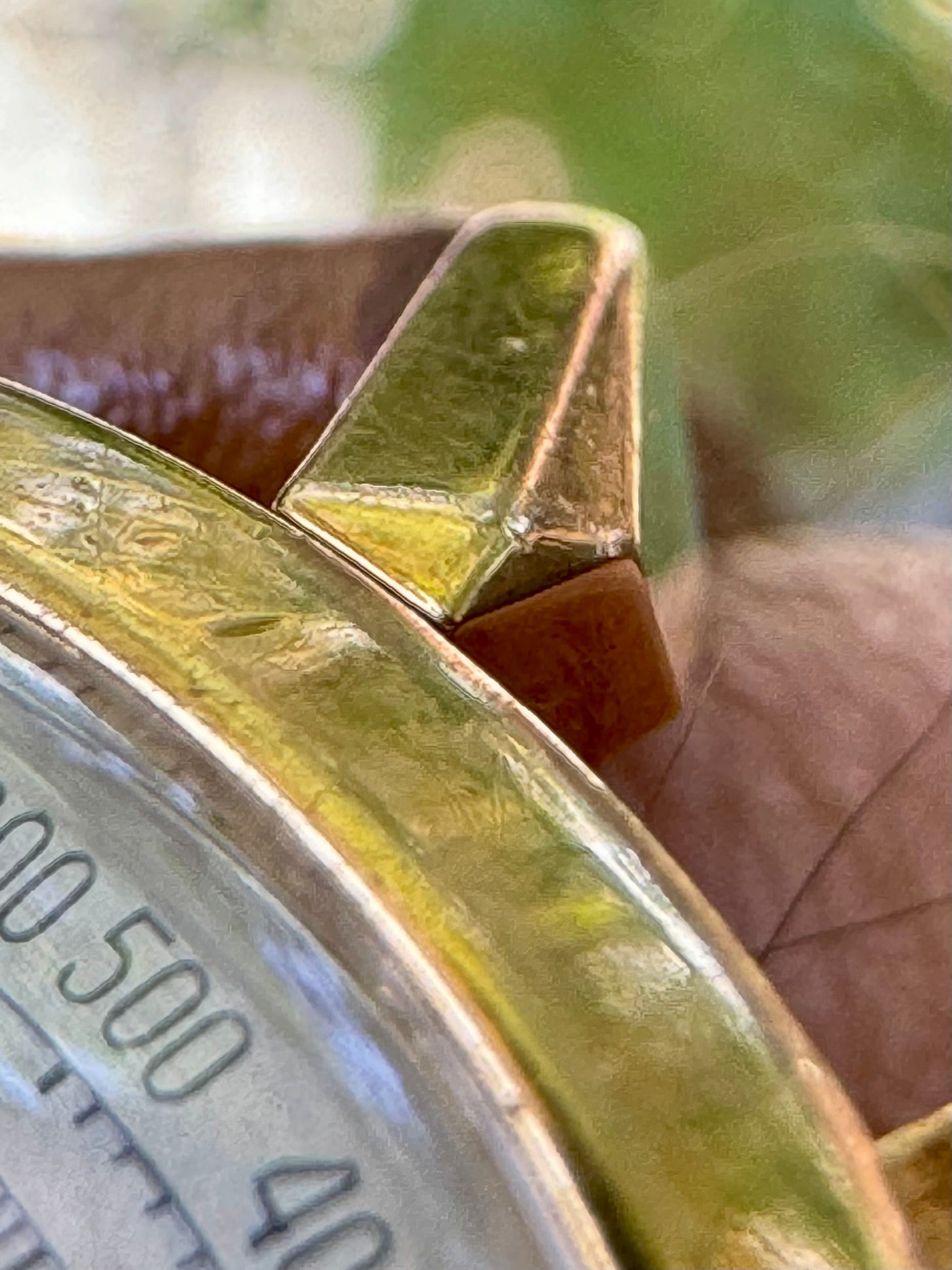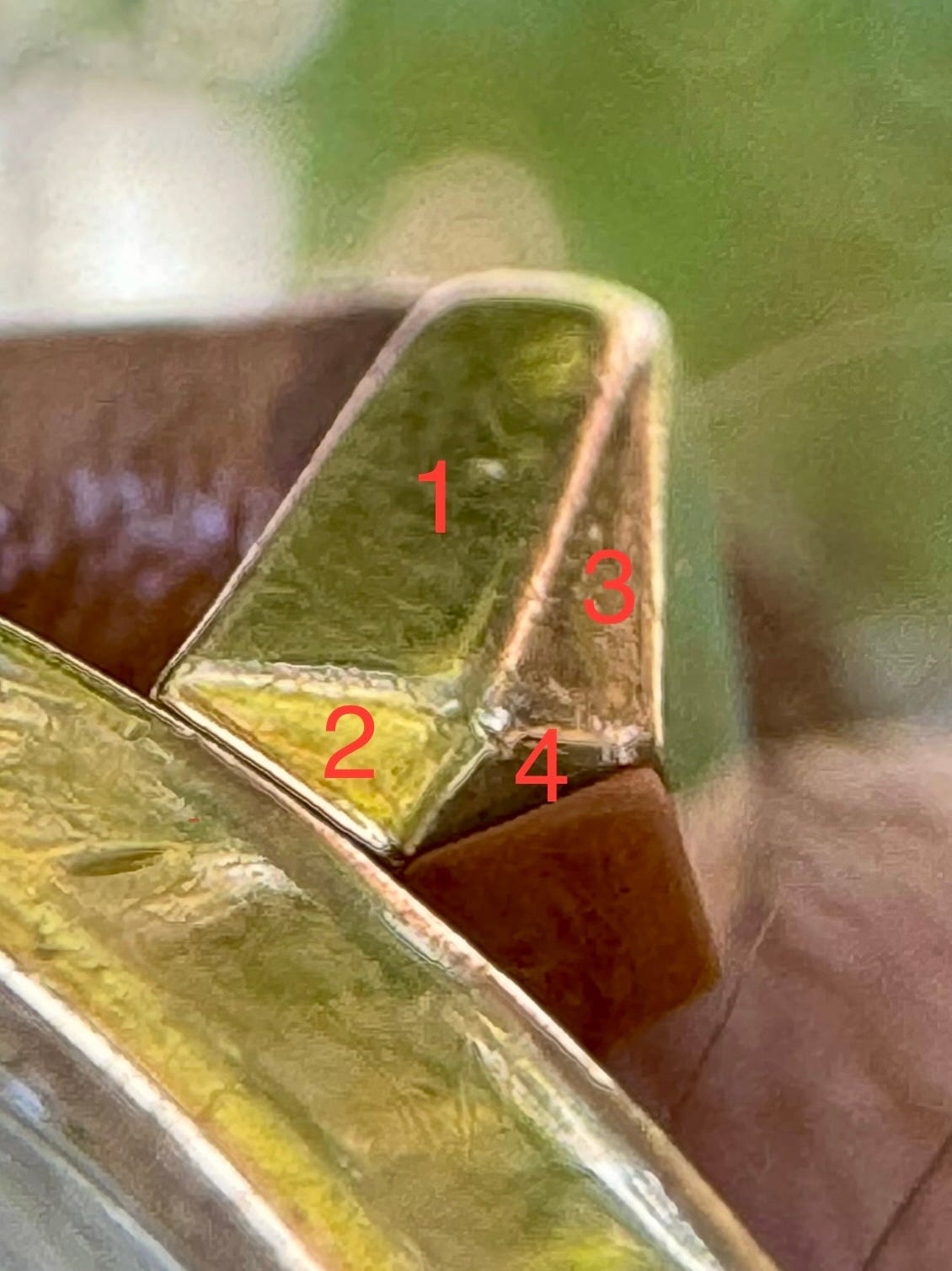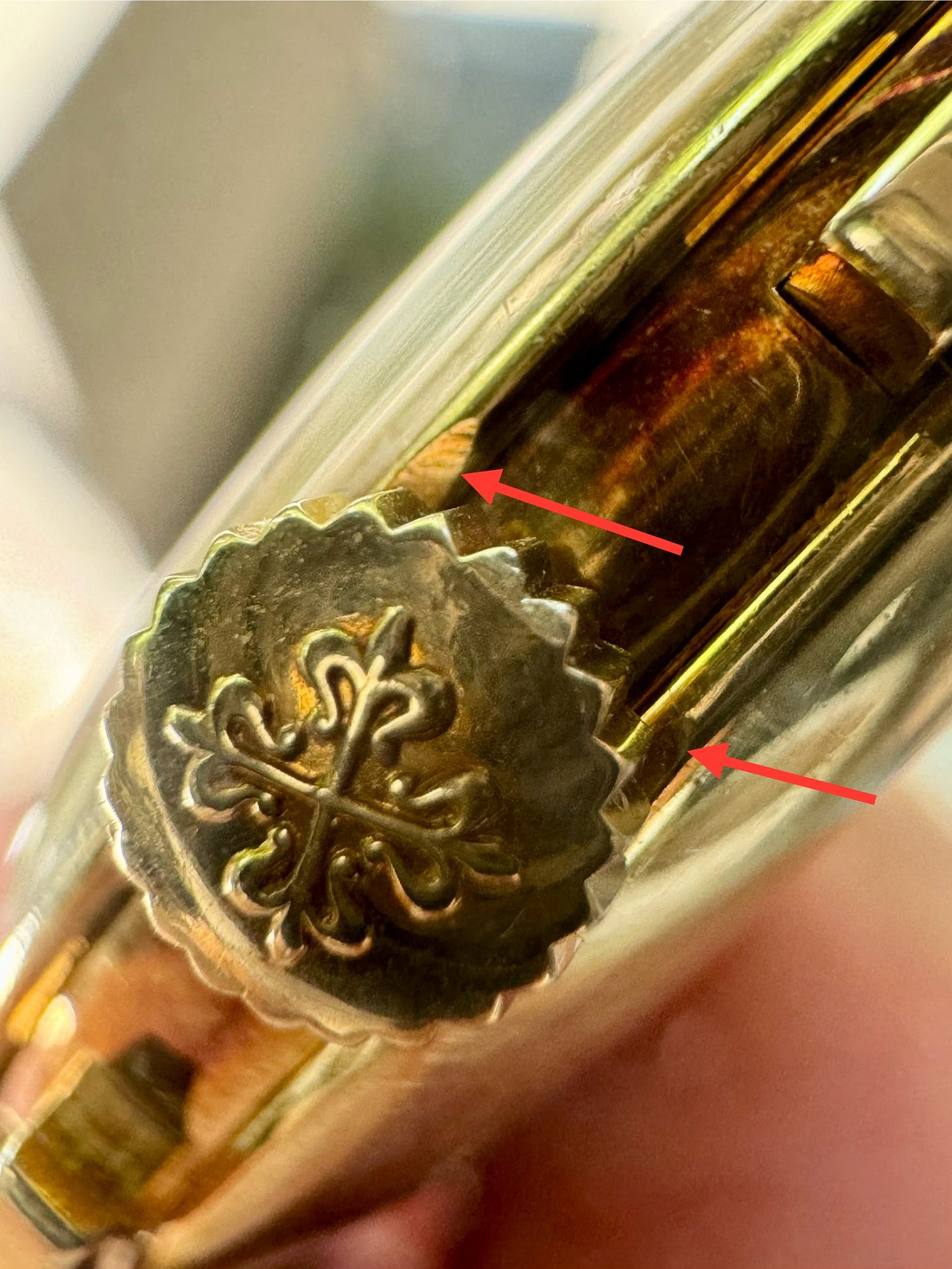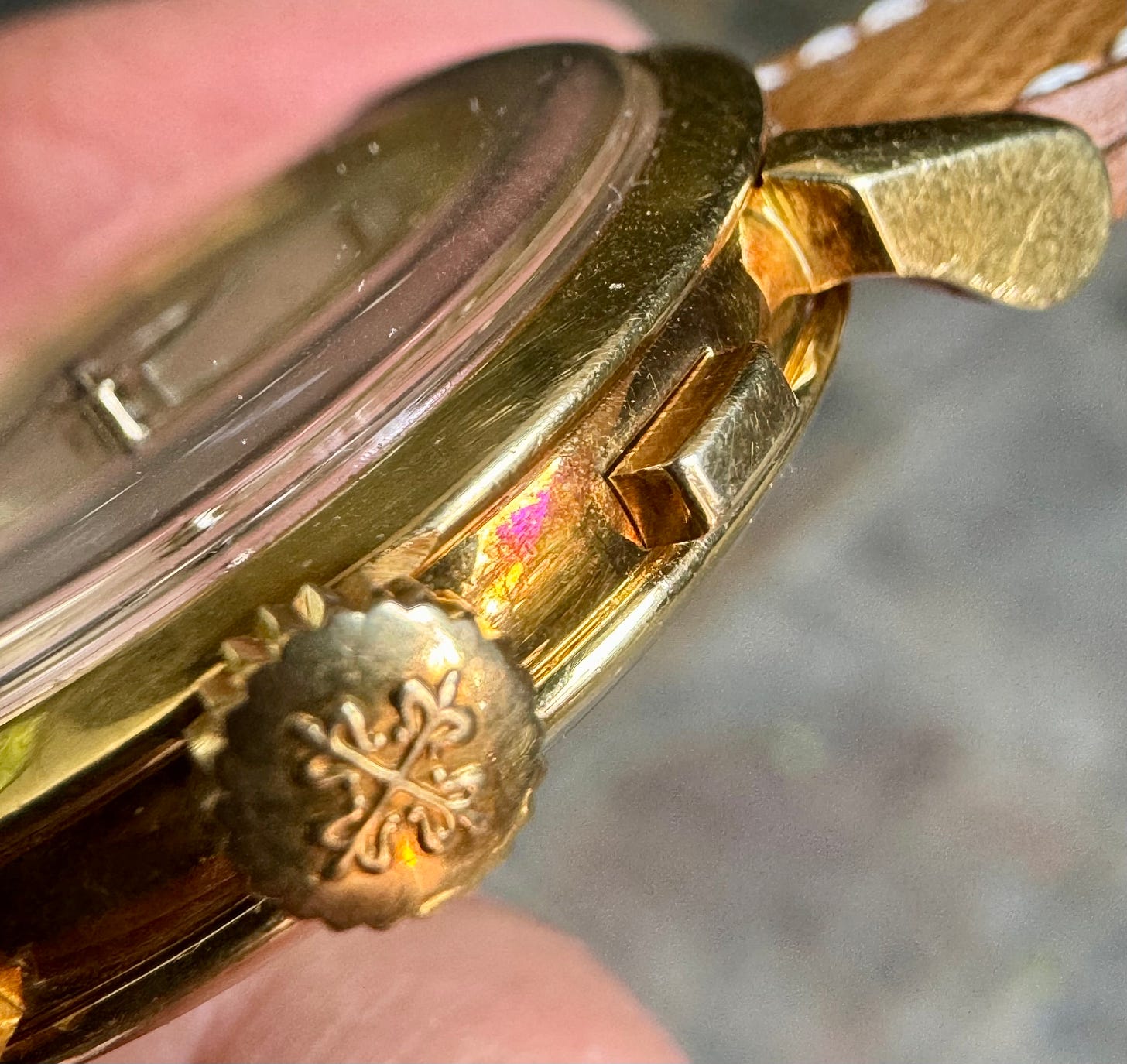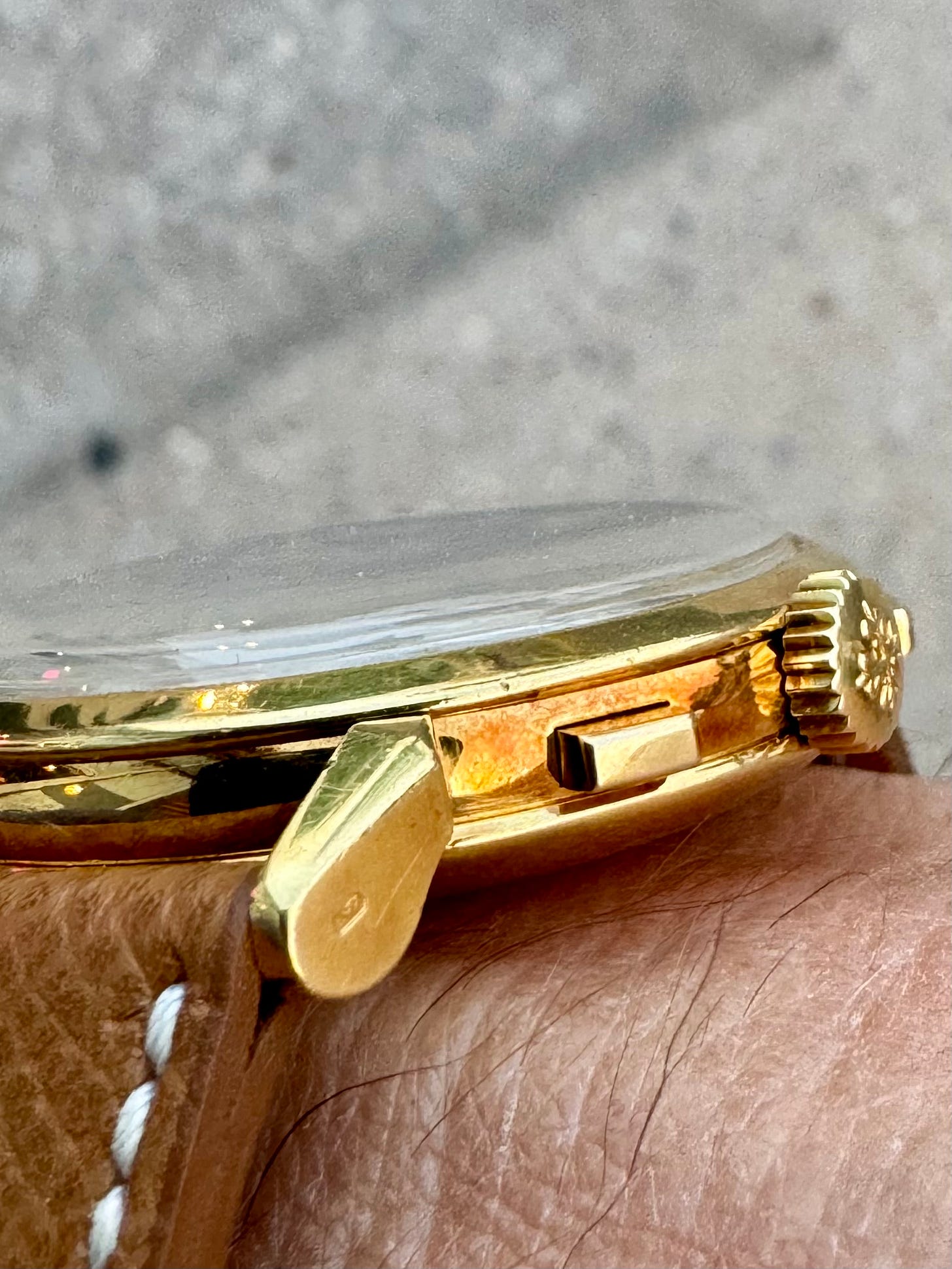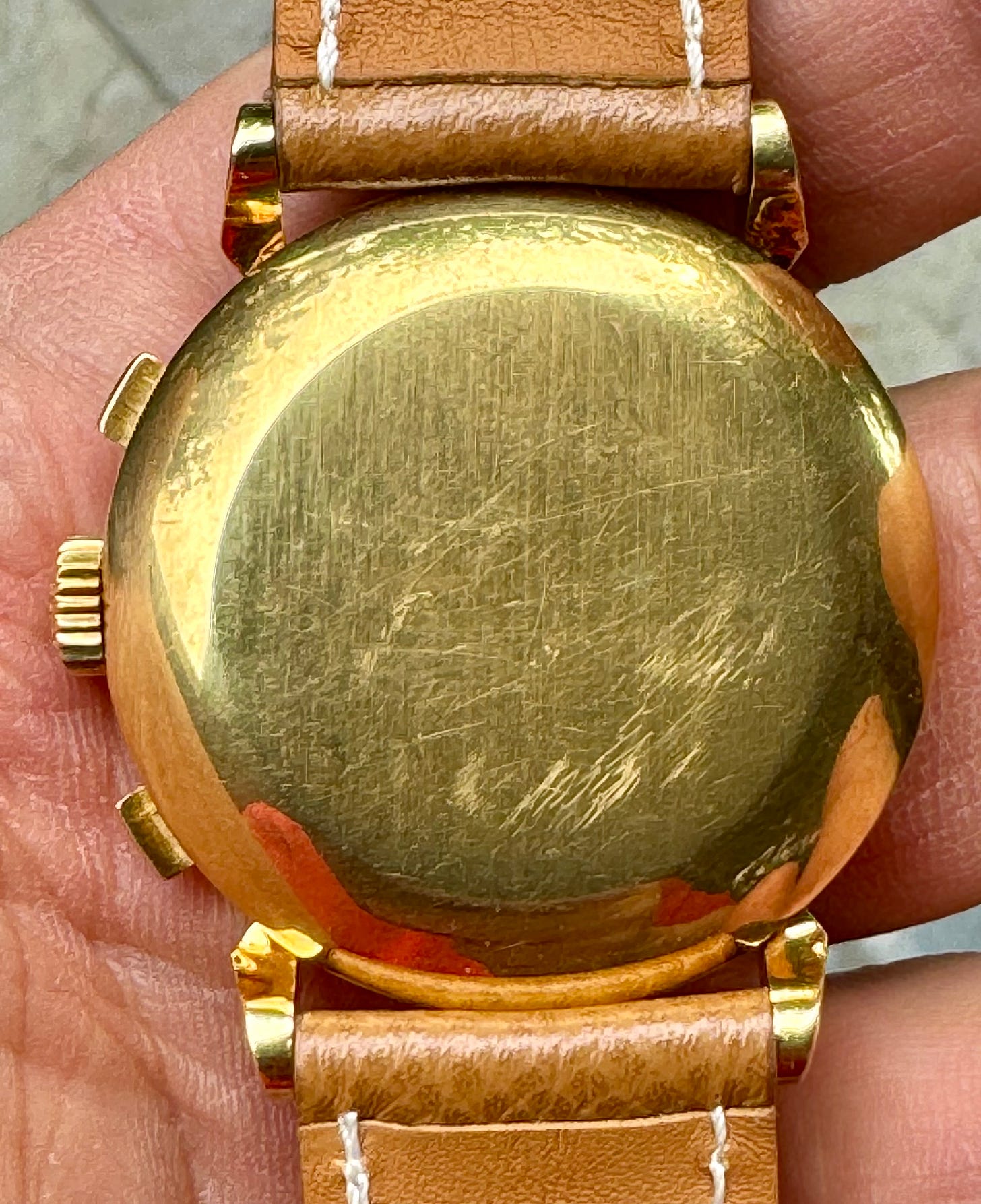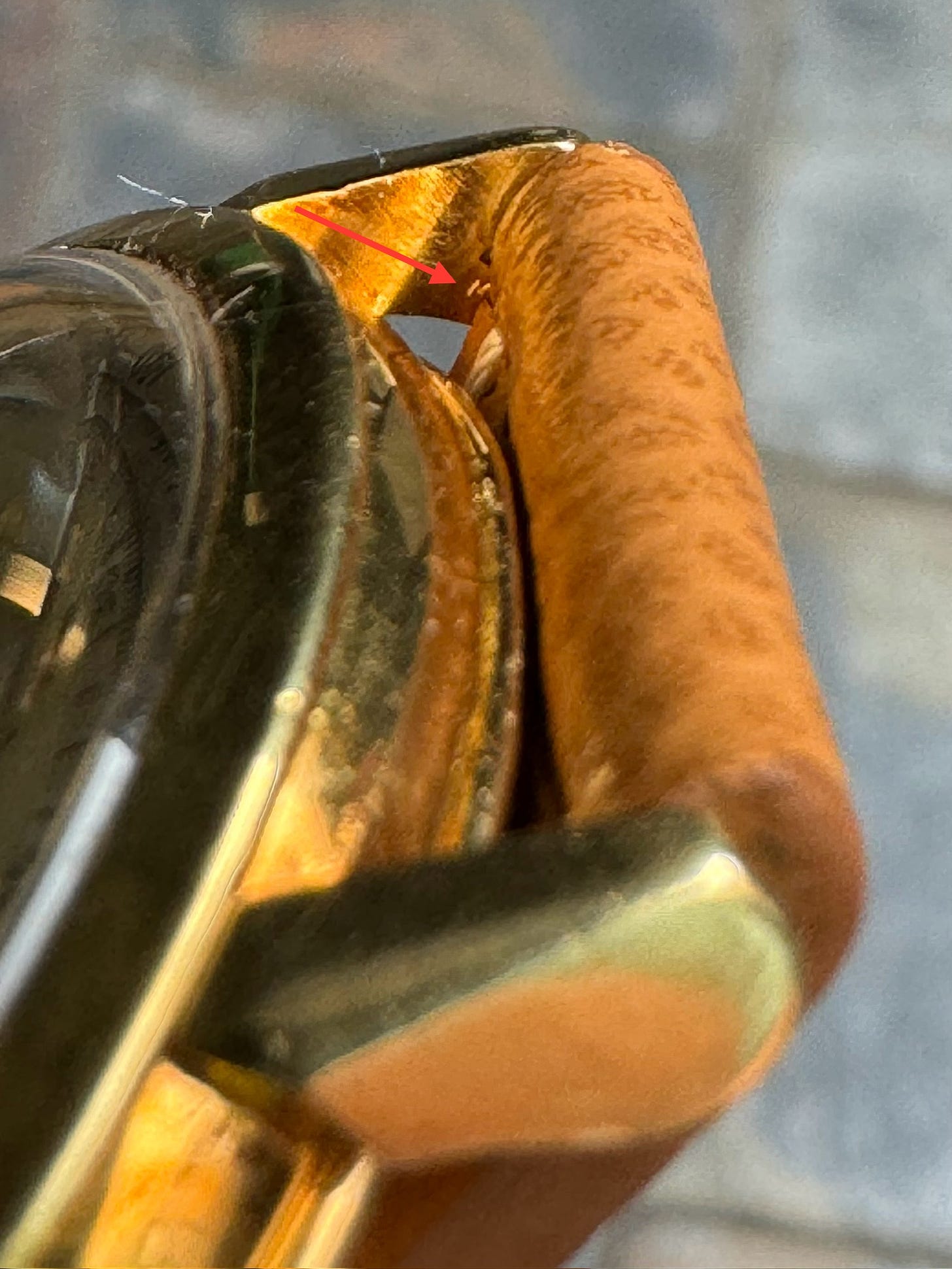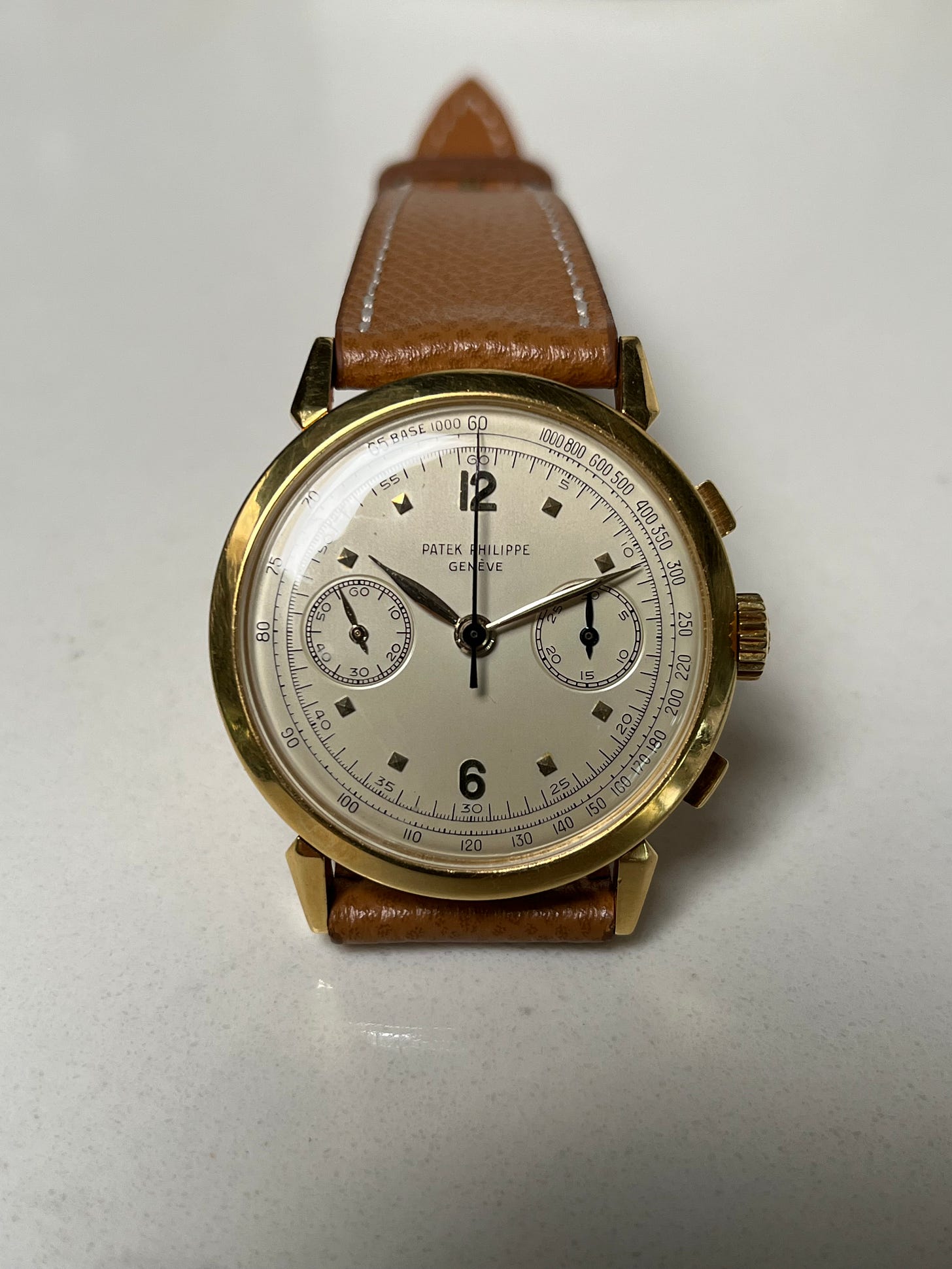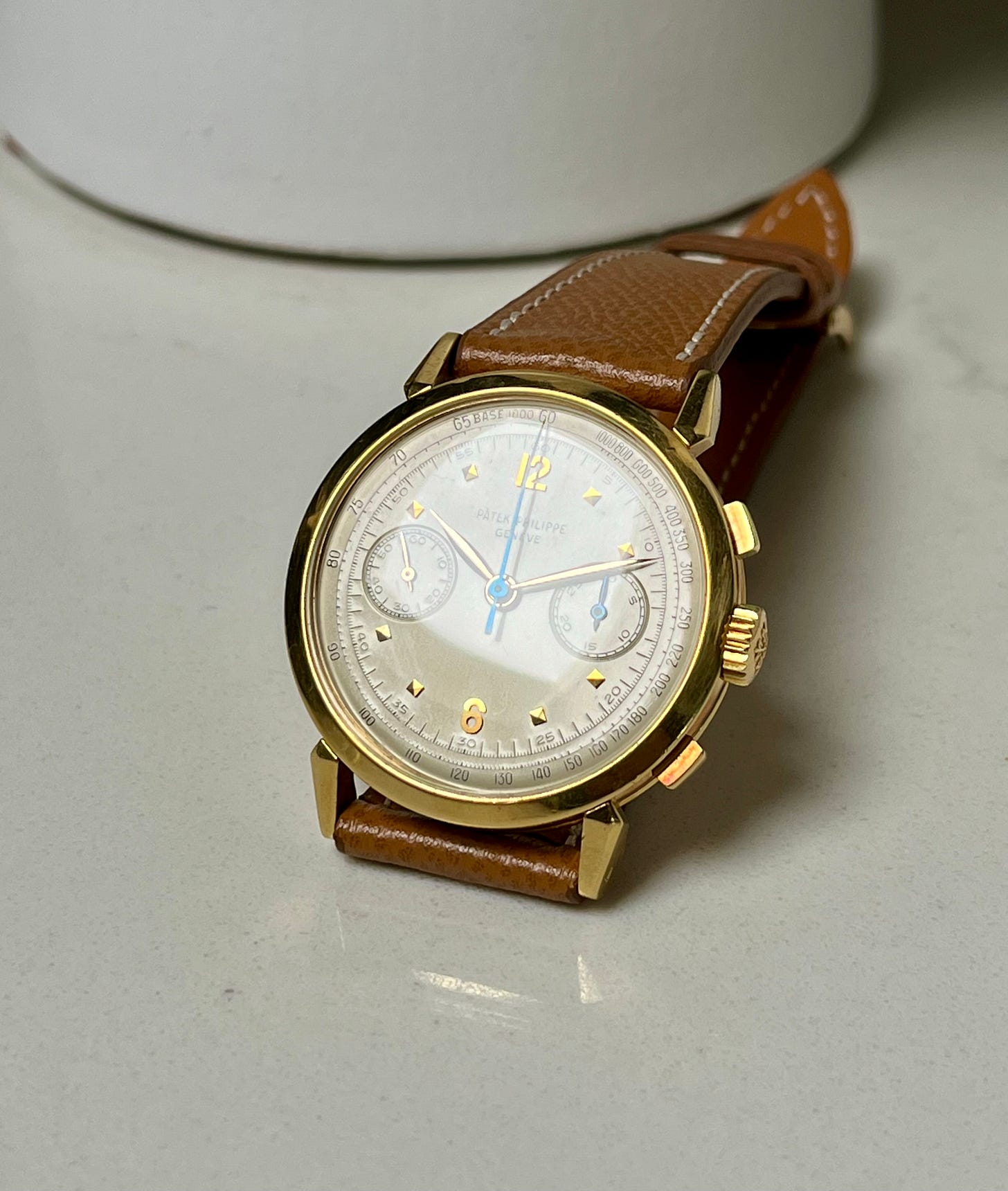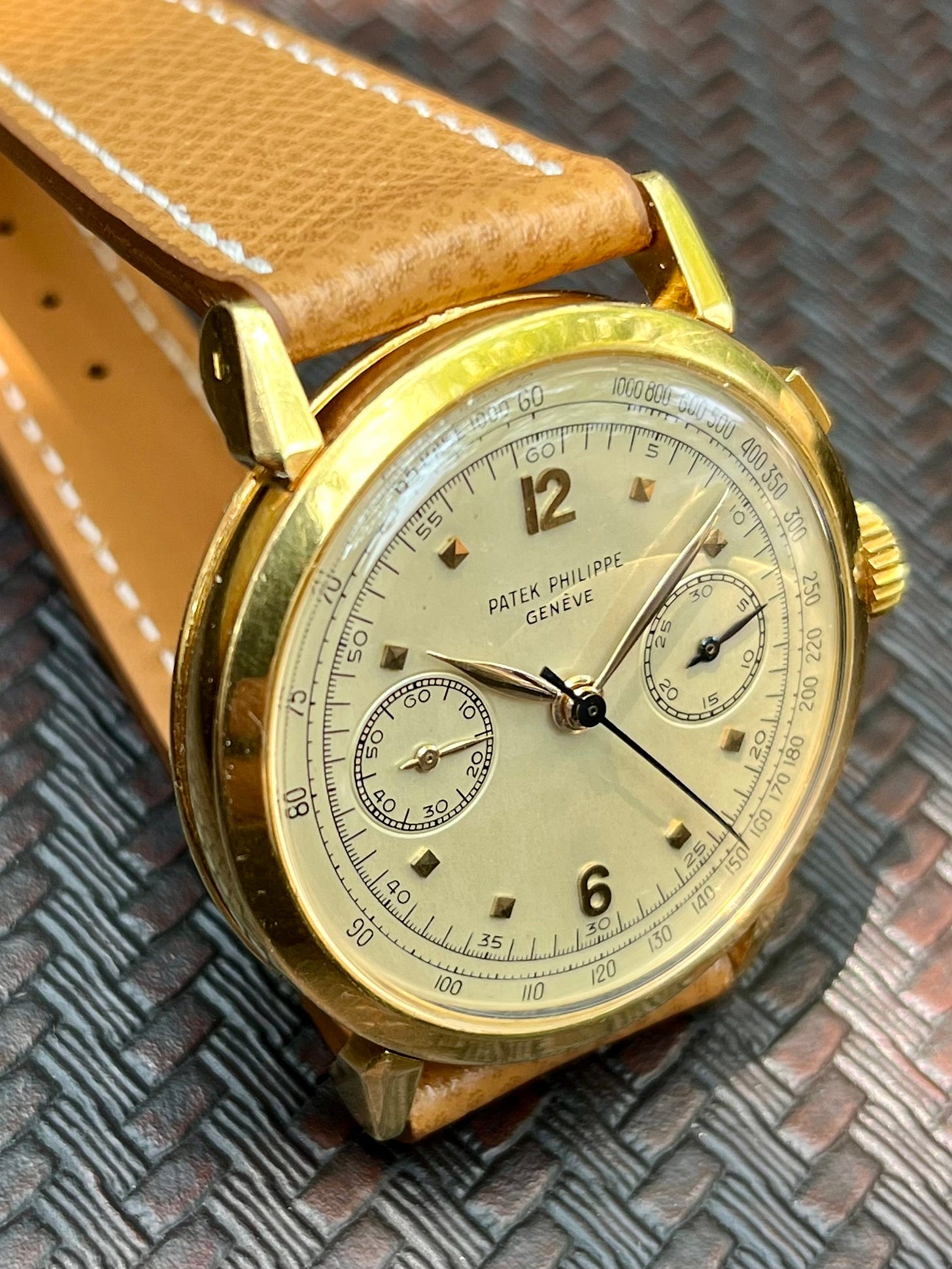Fig.1 - On the wrist.
Background
The Patek 1579 was produced from 1943 until 1964. In total, approx. 470 examples were manufactured in yellow gold (250), rose gold (185) and very few in steel (7 currently known) and platinum (3 currently known) according to published scholarship. Given the 21 year production run, the total pieces manufactured was quite low. With approx. 470 originally manufactured, it was made in lower production than several contemporary 13-130 chronograph references, including the ref. 130 (approx. 1500) and the ref. 1463 (approx. 741). In addition to the lower production, the degree of difficulty in finding a correct example with its original, unrestored dial and well preserved case is quite high.
The most rare by metal type are the two-tone examples. Two examples are known and both were retailed by Gubelin. One example is a steel and yellow gold lug variant with champagne tone dial. The other known two-tone example is steel with rose gold lugs and a silvered dial with rose gold dial markers, double signed with the retailer signature. Both of these examples are depicted in “Patek Philippe Steel Watches” authored under the pen name of John Goldberger (Auro Montanari). See following images in (Figs. 2 - 7) below for some examples of these rare variants.
Fig. 2. - Very rare rose on rose First series 1579, double signed Freccero from 1949. Sold for 177,800 CHF. Image courtesy of Phillips auctions.
Fig. 3 - 1957 Second series, Mk2 1579R with radium dots by indices and radium dauphine hands. Possibly unique example, extract confirmed. Image courtesy of Bernardini Milano.
Fig. 4 - Extremely rare 1953 yellow gold 1579 with unique engraved, enameled Breguet dial. Sold most recently after several auction appearances for 793,750 CHF in 2023. A previous result of 505,000 CHF was achieved at Christies in 2007. This is the only example of an enameled Breguet indices without outer scale dial currently known and extract confirmed. Image courtesy of Phillips auctions.
Fig. 5 - Extremely rare 1946 Platinum First series with evident signs of past restorations. Sold for 1,940,000 CHF. Image courtesy of Phillips auctions.
Fig. 6 - Extremely rare steel 1579 with Pulsometer dial. This example is the only known 1579 to bear this rare dial configuration made in steel. Movement made in 1941, case and dial made in 1950. Completed by special request in 1991. Sold for 8,769,999 HKD in 2018. Image courtesy of Sotheby’s auctions.
Fig. 7 - Extremely rare steel and yellow gold 1579 First series from 1943 with signs of a cleaned champagne tone dial. Sold for 1,107,000 CHF in 2011. Image courtesy of Christies auctions.
Yellow gold was the most common of original production with approx. 250 produced and today just a little over 100 examples are known in this metal from original production. Regardless of metal, this reference is quite difficult to find in original, unpolished or unrestored condition and few are known without some degree of restoration having been performed in the past. It’s also particularly important to find this reference with a strong case, given the stylized and unique faceted lug design. Originally sold on a leather strap, shown in a Patek catalogue from the early ‘50’s (Fig. 8)
Fig. 8 - 1951 catalogue image of a 1579 Second series, Mk1 dial. Retail price at the time was $750 USD. Image and reference courtesy of “Patek Philippe In America”, authored by John Reardon.
The Dial
Generally speaking, there was a First series and Second series dial for the 1579. The First series is noted by its alternating enameled stick and applied Arabic hour markers with thin baton style hands that debuted and appeared on the reference until 1950.
The subject example from 1956 that I’ll now focus on with more in-depth analysis, has a Second series, Mk2 dial, featuring alternating geometric pyramid shaped and arabic 12, 6 indices with leaf hands. A key difference between a Second series Mk2 dial, and a Mk1 is the “chemin de fer” or railway seconds track on the Mk1, whereas the Mk2 dial has an open track. The Second series dials were seen through final production of the reference from 1950-1964. Exceptions to these commonly known series include the possibly unique enameled Breguet dial shown in (Fig. 4), the Pulsometer dial, of which few are known and an example shown in (Fig. 6) and a Mk2 example with radium dots and dauphine hands (Fig. 3).
The subject dial is an unrestored, original dial with engraved enameled signature, sub-dial and outer tachymeter scale. A view of the backside indicates the original and consistently aged filing marks from fitment of the dial at manufacture to the movement without later signs of alterations to the dial marker feet or signs of reattachment. When dial work has been performed in the past, there are evident signs of markers being pulled off the dial and reapplied. Additional detailed views of dial shown (Figs. 9 - 12).
Fig. 9 - Dial out of case showing original engraved enamel and finishes.
Fig. 10 - Angled view of dial details and engraved, enameled signature.
Fig. 11 - Original engraved enameled seconds counter and outer tachymeter scale. Note the appropriate relief and appearance of the engraved enamel under light.
Fig. 12 - Original engraved, enameled minute counter, outer tachymeter scale. Note sign of oxidation on edge of hour marker.
The Case
Manufactured for Patek by renown casemaker Wenger, Key number 1. Wenger also made cases for the Patek 2497, 2499 (in addition to Vichet), steel 130, 2551 and 2552 among other references.
The case is a three piece, snap back design with soldered lugs. The last three digits of the matching case back serial number are stamped inside the 5 o’clock lug (Fig. 21). Serial number stampings inside a lug are also seen on other Wenger cases such as those for the 2499 and 2497. This practice is another checkpoint for ensuring a given case back matches the mid-case on these references.
The case is large for the era, measuring 36mm, which is 1mm larger than the 1463 two register chronograph sibling. The bezel is flat and creates an enhanced visual of a large dial area when viewed on the wrist. This was the only Patek chronograph made with a case featuring unique, styled lugs with intricate facets which bears the moniker of “spider lugs” among collectors. The lugs have a width of 20 mm.
Cues of originality include the appearance of facets, brushed finish on outer aspect and inner angle of lugs and deep, even hallmarks. The hallmarks show strong Helvetia head stampings and deep, even borders consistent with a case which was evidently spared from the polishing wheel and exhibits general wear from use over the years. Original brushed finish is also still evident on the case back. The facets of the case are critical to the overall appearance of this reference. When viewed from above, the lugs have four distinct facets. Often these lugs lose some of the facet lines and overall form from polishing given the delicate angles, so finding crisp examples with the original facets is not easy. It’s hard to beat a great set of lugs on this reference and common to find examples with very rounded form or with facets that have seen some enhancement to sharpen them back to original appearance. To a trained eye, signs of proportion alteration can be noted on such examples. Careful inspection of the angles, finish, symmetry and hallmarks help to confirm the state of condition. See the following for case details (Figs. 13 - 21).
Fig. 13 - 5 o’clock lug showing original finish, facets and deep, consistent hallmark with full relief.
Fig. 14 - 11 o’clock lug showing original finish, facets and deep hallmark with full relief.
Figs. 15, 16 - Detail of lug showing the original facets with wear from use. These facets are commonly lost or softened from mechanical polishing or observed as very sharp when enhanced, with changes to their original geometry. The four facets on lugs should appear as noted in Fig. 16.
The original crown features a Calatrava cross logo, which was introduced around 1955 on some models, including the 1579. A reddish hue from oxidation is seen on some aspects of the case, which is another good sign of originality (Figs. 18, 19). Upon inspection, a notched area is shown by the crown contact point with original finish. A corresponding notch is also noted on the case back (Fig. 17).
Fig. 17 - Upper bezel and upper edge of case back showing original, notched areas by crown detent.
Figs. 18, 19 - Examples of case oxidation with the magenta hue that collectors like to see.
Fig. 20 - Case back showing signs of original finish.
Fig. 21 - First digit shown, of last three matching case serial numbers on inside of 5 o’clock lug.
The Movement
Caliber 13-130 shown as preserved in exceptional condition. Adding to the charm from this era is to appreciate the art of the finishing such as anglage, perlage, Geneva waves and black polish which were performed by hand without the aid of advanced machining like today. Twice stamped with the Geneva seal. (Fig. 22) Because the case is a snapback design with square pushers that don’t have gaskets, it’s important as always, to closely note the condition of the movement for signs of how a particular example was maintained over the years. For instance, note signs of past moisture intrusion on an example recently auctioned at Antiquorum in Monaco (Fig. 23).
Fig. 22 - Showing a very well maintained 13-130 movement. Twice stamped with Geneva seal.
Fig. 23 - 13-130 movement and inner case back edge showing signs of wear and moisture intrusion. Image courtesy of Antiquorum auctions.
In summary
The 1579 has a place among the great vintage Patek chronograph references. Far fewer of the reference were manufactured over the 21 year production run than other period two register chronograph references, the ref. 130 especially and also the ref. 1463. Given the numbers known, finding a 1579 in original, well-preserved condition is difficult.
The multi-faceted lug design is unique and adds a touch of style not seen on other chronographs from the era. This reference has a great balance of wrist presence without being too large or too small for most wrists. Subject example is shown on an Hermes style strap with the original gold buckle (Fig. 24). Given the stylized lug design, this reference may wear best on a strap as originally offered as opposed to a bracelet to avoid eye distraction with the lugs, but either option may work well. A few final pics to share in (Figs. 24 - 27). Thanks for reading.
@aircooltime
Fig. 24 - Original yellow gold tang buckle with stampings.
Fig. 25 - Front profile.
Fig. 26 - Angled profile highlighting the engraved enamel, indices and original case form features.
Fig. 27 - Opposite profile view. Note the crisp case and deep hallmark original forms.






